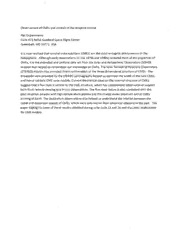
NASA Technical Reports Server (NTRS) 20120013112: Observations of CMEs and Models of the Eruptive Corona PDF
Preview NASA Technical Reports Server (NTRS) 20120013112: Observations of CMEs and Models of the Eruptive Corona
Observations of CMEs and models of the eruptive corona Nat Gopalswamy Code 671 NASA Goddard Space Flight Center Greenbelt, MD 20771, USA It is now realized that coronal mass ejections (CMEs) are the most energetic phenomenon in the heliosphere. Although early observations (in the 1970s and 19805) revealed most of the properties of CMEs, it is the extended and uniform data set from the Solar and Heliospheric Observatory (SOHO) mission that helped us consolidate our knowledge on CMEs. The Solar Terrestrial Relations Observatory (STEREO) mission has provided direct confirmation of the three-dimensional structure of CMEs. The broadside view provided by the STEREO coronagraphs helped us estimate the width of the halo CMEs and hence validate CME cone models. Current theoretical ideas on the internal structure of CMEs suggest that a flux rope is central to the CME structure, which has considerable observational support both from remote-sensing and in-situ observations. The flux-rope nature is also consistent with the post-eruption arcades with high-temperature plasma and the charge states observed within CMEs arriving at Earth. The quadrature observations also helped us understand the relation between the radial and expansion speeds of CMEs, which were only known from empirical relations in the past. This paper highlights some of these results obtained during solar cycle 23 and 24 and discusses implications for CME models.
